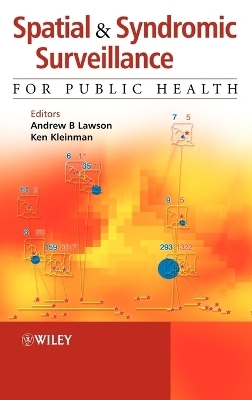
Spatial and Syndromic Surveillance for Public Health
John Wiley & Sons Inc (Verlag)
978-0-470-09248-4 (ISBN)
- Lieferbar (Termin unbekannt)
- Versandkostenfrei
- Auch auf Rechnung
- Artikel merken
Provides an overview of the current key methods in spatial surveillance of public health data.
Includes coverage of both single and multiple disease surveillance.
Covers all of the key topics, including syndromic surveillance, spatial cluster detection, and Bayesian data mining.
Andrew Lawson, Department of Epidemiology and Biostatistics, University of South Carolina, USA Andrew has published many papers in leading journals, and a number of books on spatial statistics, including four for Wiley. Ken Kleinman, Department of Ambulatory Care and Prevention, Harvard Medical School, Boston, USA Ken is an epidemiologist who specializes in disease surveillance, and has recently worked on projects modeling the spread of anthrax following a potential terrorist attack.
Preface. List of Contributors.
1 Introduction: Spatial and syndromic surveillance for public health (Andrew B. Lawson and Ken Kleinman).
1.1 What is public health surveillance?
1.2 The increased importance of public health surveillance.
1.3 Geographic information, cluster detection and spatial surveillance.
1.4 Surveillance and screening.
1.5 Overview of process control and mapping.
1.6 The purpose of this book.
1.7 The contents of this book.
Part I: Introduction to Temporal Surveillance.
2 Overview of temporal surveillance (Yann Le Strat).
2.1 Introduction.
2.2 Statistical methods.
2.3 Conclusion.
3 Optimal surveillance (Marianne Frisén and Christian Sonesson).
3.1 Introduction.
3.2 Optimality for a fixed sample and for on-line surveillance.
3.3 Specification of the statistical surveillance problem.
3.4 Evaluations of systems for surveillance.
3.5 Optimality criteria.
3.6.1 The likelihood ratio method.
3.7 Special aspects of optimality for surveillance of public health.
3.8 Concluding remarks.
Acknowledgment.
Part II: Basic Methods for Spatial and Syndromic Surveillance.
4 Spatial and spatio-temporal disease analysis (Andrew B. Lawson).
4.1 Introduction.
4.2 Disease mapping and map reconstruction.
4.3 Disease map restoration.
4.4 Residuals and goodness of fit.
4.5 Spatio-temporal analysis.
4.6 Surveillance issues.
5 Generalized linear models and generalized linear mixed models for small-area surveillance (Ken Kleinman).
5.1 Introduction.
5.2 Surveillance using small-area modeling.
5.3 Alternate model formulations.
5.4 Practical variations.
5.5 Data.
5.6 Evaluation.
5.7 Conclusion.
6 Spatial surveillance and cumulative sum methods (Peter A. Rogerson).
6.1 Introduction.
6.2 Statistical process control.
6.3 Cumulative sum methods for spatial surveillance.
6.4 Summary and discussion.
Acknowledgments.
Appendix.
7 Scan statistics for geographical disease surveillance: an overview (Martin Kulldorff).
7.1 Introduction.
7.2 Scan statistics for geographical disease surveillance.
7.3 Secondary clusters.
7.4 Null and alternative hypotheses.
7.5 Power.
7.6 Visualizing the detected clusters.
7.7 A Sample of applications.
7.8 Software.
Acknowledgment.
8 Distance-based methods for spatial and spatio-temporal surveillance (Laura Forsberg, Marco Bonetti, Caroline Jeffery, Al Ozonoff and Marcello Pagano).
8.1 Introduction.
8.2 Motivation.
8.3 Distance-based statistics for surveillance.
8.4 Spatio-temporal surveillance: an example.
8.5 Locating clusters.
8.6 Conclusion.
Acknowledgments.
9 Multivariate surveillance (Christian Sonesson and Marianne Frisén).
9.1 Introduction.
9.2 Specifications.
9.3 Approaches to multivariate surveillance.
9.4 Evaluation of the properties of multivariate surveillance methods.
9.5 Concluding discussion.
Part III: Database Mining and Bayesian Methods.
10 Bayesian network approaches to detection (Weng-Keen Wong and Andrew W. Moore).
10.1 Introduction.
10.2 Association rules.
10.3 WSARE.
10.4 Evaluation.
10.5 Results.
10.6 Conclusion.
11 Efficient scan statistic computations (Daniel B. Neill and Andrew W. Moore)
11.1 Introduction.
11.2 Overlap-multiresolution partitioning.
11.3 Results.
11.4 Conclusions and future work.
12 Bayesian data mining for health surveillance (David Madigan).
12.1 Introduction.
12.2 Probabilistic graphical models.
12.3 Hidden Markov models for surveillance: illustrative examples.
12.4 Hidden Markov models for surveillance: further exploration.
12.5 Random observation time hidden Markov models.
12.6 Interpretation of hidden Markov models for surveillance.
12.7 Discussion.
Acknowledgments.
13 Advanced modeling for surveillance: clustering of relative risk changes (Andrew B. Lawson).
13.1 Introduction.
13.2 Cluster concepts.
13.3 Cluster modeling.
13.4 Syndromic cluster assessment.
13.5 Bayesian version of the optimal surveillance alarm function.
13.6 Computational issues.
13.7 Conclusions and future directions.
References.
Index.
| Erscheint lt. Verlag | 4.5.2005 |
|---|---|
| Verlagsort | New York |
| Sprache | englisch |
| Maße | 160 x 232 mm |
| Gewicht | 539 g |
| Themenwelt | Studium ► Querschnittsbereiche ► Prävention / Gesundheitsförderung |
| ISBN-10 | 0-470-09248-3 / 0470092483 |
| ISBN-13 | 978-0-470-09248-4 / 9780470092484 |
| Zustand | Neuware |
| Haben Sie eine Frage zum Produkt? |
aus dem Bereich


